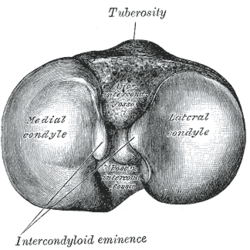Condyle
Appearance
| Condyle | |
|---|---|
 Upper surface of right tibia. | |
| Details | |
| Identifiers | |
| Latin | condylus |
| TA98 | A02.0.00.029 |
| FMA | 75434 |
| Anatomical terms of bone | |
A condyle (/ˈkɒndɪl, -daɪl/;[1][2] Latin: condylus, from Greek: kondylos; κόνδυλος knuckle) is the round prominence at the end of a bone, most often part of a joint – an articulation with another bone. It is one of the markings or features of bones, and can refer to:
- On the femur, in the knee joint:
- On the tibia, in the knee joint:
- On the humerus, in the elbow joint:
- Condyle of humerus (Condylus humeri)
- On the mandible, in the temporomandibular joint:
- On the occipital bone, in the atlanto-occipital joint:
Although not generally termed condyles, the trochlea and capitulum of the humerus act as condyles in the elbow, and the femur head acts as a condyle in the hip joint.
Condyle may also be used to describe an intrusion of the endocarp into the seed cavity of flowering plants like Abuta.
References
[edit] The dictionary definition of condyle at Wiktionary
The dictionary definition of condyle at Wiktionary
- ^ OED 2nd edition, 1989.
- ^ Entry "condyle" in Merriam-Webster Online Dictionary.
